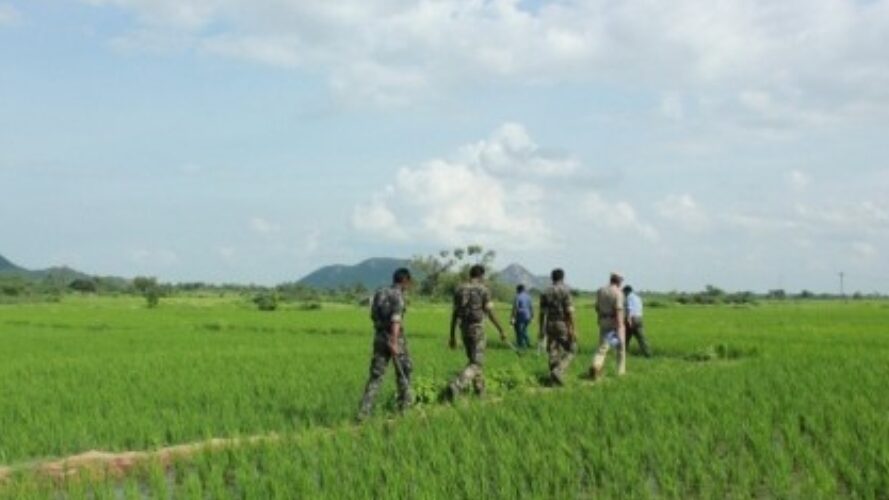Runaway Slaves Get Help for Loved Ones Still Trapped
Slavery
The smell of burnt charcoal clings to Kalappa’s* skin as he speaks. He raises his eyes and looks at the government official standing in front of him.
“If you hadn’t rescued me, I would have died,” Kalappa says.
Kalappa is one of 16 people rescued from a life of slavery last month in India. Several families—including children as young as 6—were trapped as slaves collecting, chopping and burning chunks of wood into charcoal.
These families are among nearly 30 million people living in slavery worldwide. More than 10 million forced labor slaves are estimated to live in India alone, and IJM has worked with government officials on hundreds of cases.
But for Abishek Joseph, a social worker with IJM Delhi, Kalappa’s case stands out: “In nine years of fieldwork, I’ve never seen a case of such abuse, where families were separated and scattered from one place to another
Life in Slavery
Kalappa’s story illustrates how modern-day slavery works. He took a job making charcoal hundreds of miles away from his village. The business owner offered an advance payment, explaining that Kalappa would repay it through his labor. But the loan was a trap. Kalappa became a slave.
Kalappa and the others trapped with him toiled around the clock, barely breaking to sleep in the same open field where they burned the wood into charcoal. Their children were not allowed to go to school, and many started working alongside the adults to help meet impossible quotas. They had no clean water, proper toilets, or shelter.
One woman told about a flood that destroyed all their meagre belongings last year. When they called the owner for help, he told them to hide out under the trees and said he would come in the morning—if they were still alive. They survived, and the next day the woman stood up to the owner and begged his help to build a shelter.
The owner responded by beating her. She still has scars from the wooden plank.
Most Escaped, but Everyone Lived in Fear of Being Kidnapped
Fearful for their lives, Kalappa and the families escaped that same night. They managed to get back home, find work and enroll their children in school. But the terror they suffered as slaves was not over.
According to the stories Kalappa and the others shared with the government official, the owner showed up at their village four times in less than a year, each time abducting someone to return to work at his business.
Desperate to get their loved ones back—and to stop the abductions—the grief-stricken families turned to a local organization known for helping their historically marginalized people-group. This organization, Association for Rural Development (ARD), called IJM to develop a plan to set the captives free and keep all of the families safe.
Not a Straightforward Rescue Operation
This would not be a straightforward rescue operation. IJM and ARD briefed a team of officials on Friday, September 5, 2014. The first step was finding the men and women who had been kidnapped. Kalappa was the first one they found.
As the rescue team explained why they were there, Kalappa opened up. He said that just a few days earlier the owner had held a knife to his throat and forced him to call his wife to get money. He said his wife sold the family’s four goats—their only source of livelihood—and transferred the money to the owner’s bank account.
Another man and woman were found and rescued; but the fourth woman was missing. No one had seen her for several weeks.
The other family members were reunited with the rescued slaves at a district government office.
IJM and ARD staff supported the families and made sure they had meals as they waited for the official interviews. One by one, the official asked each person a set of questions. Their stories painted a dark picture of modern-day slavery.
Nine people, including 6- and 10-year-old brothers, received official release certificates. These legal documents declare them free from slavery, protecting them from the owner and entitling them to government benefits.
The Story is Still Unfolding
Just two days after the government officials and ARD staff escorted all of the survivors home—this time secured in their freedom—the woman who had still been missing walked into the village.
The missing mother told how the owner had snatched her in the village to take her back to the charcoal business. She explained how the owner abused her, physically and verbally, treating her as if she were his property. Amazingly, she seized an opportunity to escape when the owner stopped for tea at a roadside stand. With no money and no way to contact her family, she had been forced to beg and made her way back home on foot. That journey had taken 45 days.
These families are now living free and will get ongoing support from ARD. The next step will be holding the charcoal business owner accountable for his crimes. In India, statistics indicate that it is more likely for a slave owner to be struck by lightning than ever being sent to prison. IJM will continue to follow up on the case and work closely with state prosecutors so that he is restrained from harming others.
Freedom Partners give $24 a month, so IJM can show up 24 hours a day. Will you send us?